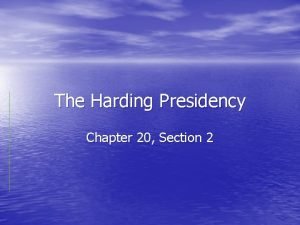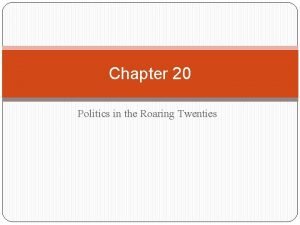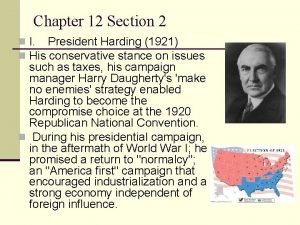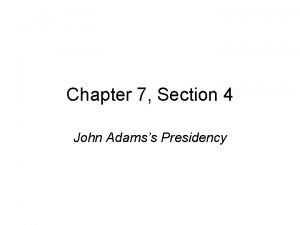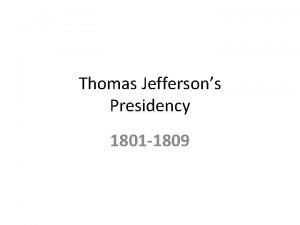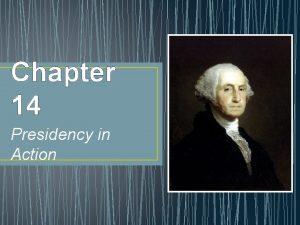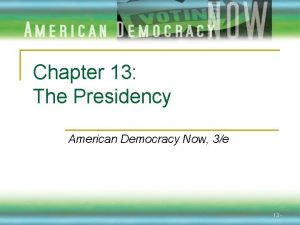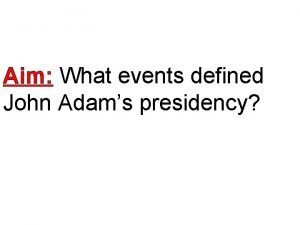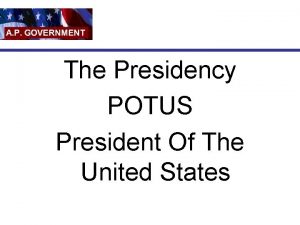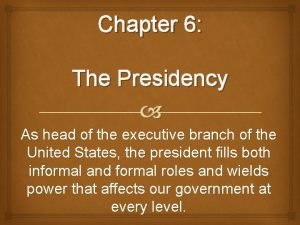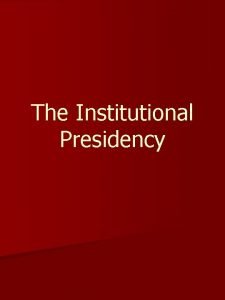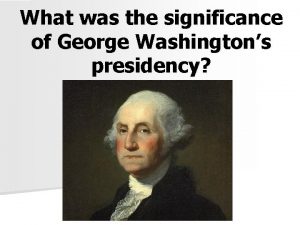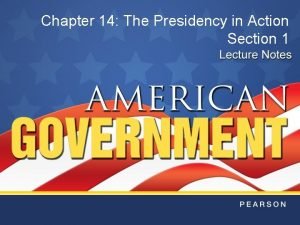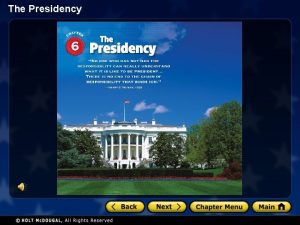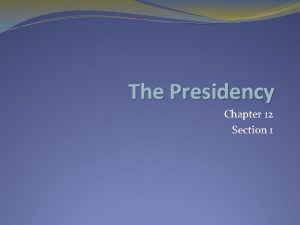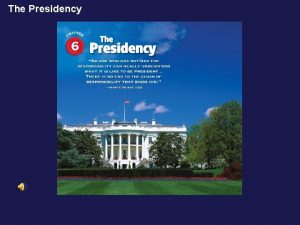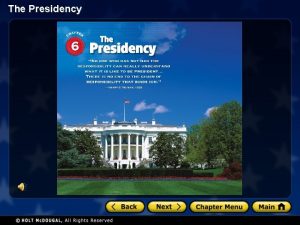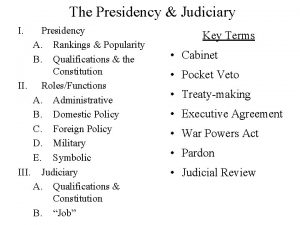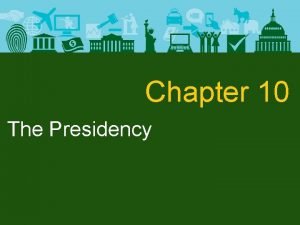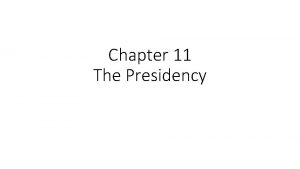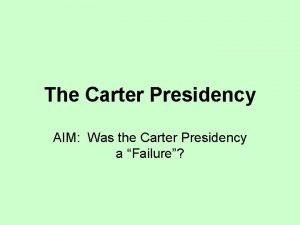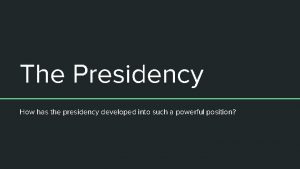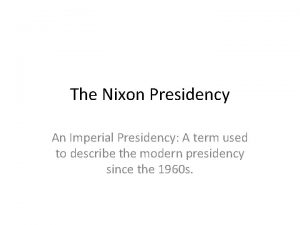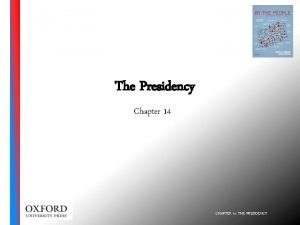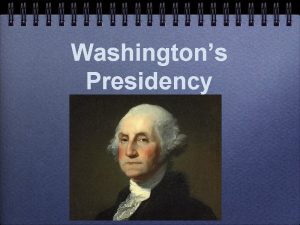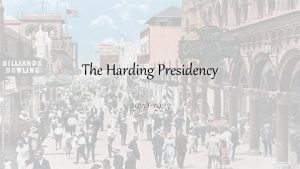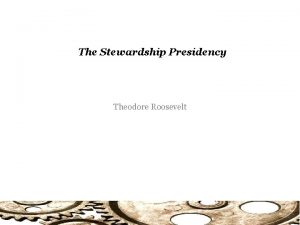The Presidency The Presidency Section 1 The Presidency
















- Slides: 16

The Presidency

The Presidency Section 1

The Presidency ► Qualifications to become President: 1. Natural born citizen of the United States. 2. Must be at least 35 years old. 3. Must be a resident of the U. S. for 14 years. -Part of the American Dream is that anyone can become President if they meet the qualifications.

Roles of the President 1. Chief of State: ceremonial head of the government. -In other countries, this title is usually given to someone who is not in charge. In England, it is the Queen. 2. Chief Executive: Head of the executive branch. His job is to enforce the acts of Congress and carry out the judgments of the federal courts. -As Chief Executive, the President has the power to grant reprieves and pardons for offenses against the U. S.

Roles of the President 3. Commander in Chief: Supreme Commander of the military. -President carries the “football”, which is a briefcase full of nuclear codes that the President uses to authorize a nuclear attack. -President can send troops into battle without Congress declaring war. -To check this power of the President, Congress passed the War Powers Resolution that states the President must report to Congress within 48 hours of deploying troops. Congress has 60 days to approve this action or the troops must be brought back.

Roles of the President 4. Chief Diplomat: President serves as the chief negotiator with foreign governments. -President has the power to refuse or recognize foreign governments. -President has the sole power to make treaties with other nations, but treaties must be approved by the Senate. -To get around this, the President can make an executive agreement with the head of another nation. This agreement does not have to be approved by the Senate. -The difference between the two is that treaties are binding from President to President whereas executive agreements are not.

Roles of the President 5. Chief Legislator: Influences the make of laws. -FDR and the New Deal. -President can influence the Congressional agenda through his State of the Union Address. -President can also veto proposed laws from Congress. -President may use the pocket veto: By law, if the president does not sign a bill within 10 days, then it automatically becomes a law. But, if Congress adjourns within that 10 day period, then the president does not have to sign the bill and it does not become a law, therefore we call it a pocket veto.

Roles of the President 6. Chief of Party: head of the national party. -Rewards loyal party members with government jobs. -The President has a list of jobs that he is allowed to select people for. This is compiled in book called the “Plum Book”.

The Presidency Section 2

Three Powers of the Presidency Emergency Powers: an inherent power exercised by the president during a period of national crisis. 2. Executive Orders: enforces legislative laws, enforces the Constitution and treaties with other nations, and establishes or modifies rules and practices of executive agencies. 3. Executive Privilege: President can refuse to appear before Congress unless it is a criminal matter. -If the president abuses his powers, then he can become impeached. No president has ever been impeached and convicted by Congress. 1.

Electing a President ► The journey to become the president is a long one. ► Candidates are either self-selected or chosen by the major parties to run for office. ► Potential candidates must first win the parties’ nomination through winning several primaries. ► Candidates receive official nomination at each parties’ national convention. ► Once the candidate receives the nomination, they must being campaigning for the national presidential election.

Electing a President ► ► ► ► On election day, the general public votes for the candidate they wish to see in office. In reality, the public is not voting for president, but actually vote for electors who vote in the Electoral College. The Electoral College is a group of voters selected in each state who actually vote for the President. The number of Electoral Votes each state has is equal to the number of Congressmen in that state. There a total of 538 electoral votes. In order to become President, a candidate must with 270 electoral votes. If the top candidate receives less than 270 electoral votes, then Congress decides through voting who would become President and Vice President. The Electoral College does not vote until the first Monday after the second Wednesday in December.

The Presidency Section 3

Executive Organization ► The president selects a group of advisors known as the Cabinet. ► The 1 st Cabinet only had four posts: Secretary of State, Treasury, War, and the Attorney General. ► Today, there are 15 positions in the Cabinet. ► Presidents may use a few close friends as advisors. We call this the “Kitchen Cabinet”. ► Some presidents have relied on the advice of their cabinets more than others.

The Vice Presidency ► The Vice President is mainly chosen to balance the election ticket. ► The VP does not have a very demanding job. ► He is there mainly to support the President’s activities and may be a key advisor. ► He serves as the President of the Senate and votes in case there is a tie. ► Some Vice Presidents go on to become President.

Presidential Succession ► ► The line of presidential succession is outlined in the 25 th Amendment and then further expanded in the Presidential Succession Act. Order of Presidential Succession: 1. Vice President 2. Speak of the House of Representatives 3. Senate Pro Tempore 4. Secretary of State If the Vice President becomes ill, then the President nominates someone new who then has to be approved by a 2/3 vote in Congress. If the President is temporarily ill, he can give his power to the Vice President to use while the president is ill.
 Chapter 12 section 2 the harding presidency
Chapter 12 section 2 the harding presidency Chapter 20 section 2 the harding presidency
Chapter 20 section 2 the harding presidency Ch 12 section 2 the harding presidency
Ch 12 section 2 the harding presidency Chapter 6 section 1 the presidency
Chapter 6 section 1 the presidency Section 4 the presidency of john adams
Section 4 the presidency of john adams What were president jeffersons economic policies
What were president jeffersons economic policies Chief of state examples president
Chief of state examples president Constructionist presidency
Constructionist presidency Chapter 13 the presidency
Chapter 13 the presidency What major events happened during john adams presidency
What major events happened during john adams presidency Which trend characterized thomas jefferson's presidency?
Which trend characterized thomas jefferson's presidency? Presidential line of succession
Presidential line of succession George washingtons presidency
George washingtons presidency Chapter 6 the presidency
Chapter 6 the presidency Institutional presidency definition
Institutional presidency definition George washingtons presidency
George washingtons presidency Chapter 14 the presidency in action
Chapter 14 the presidency in action
